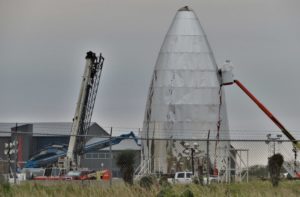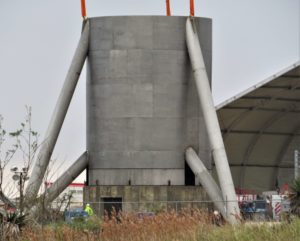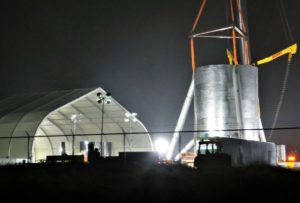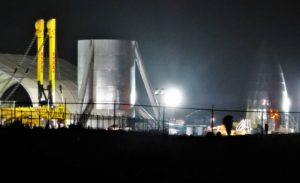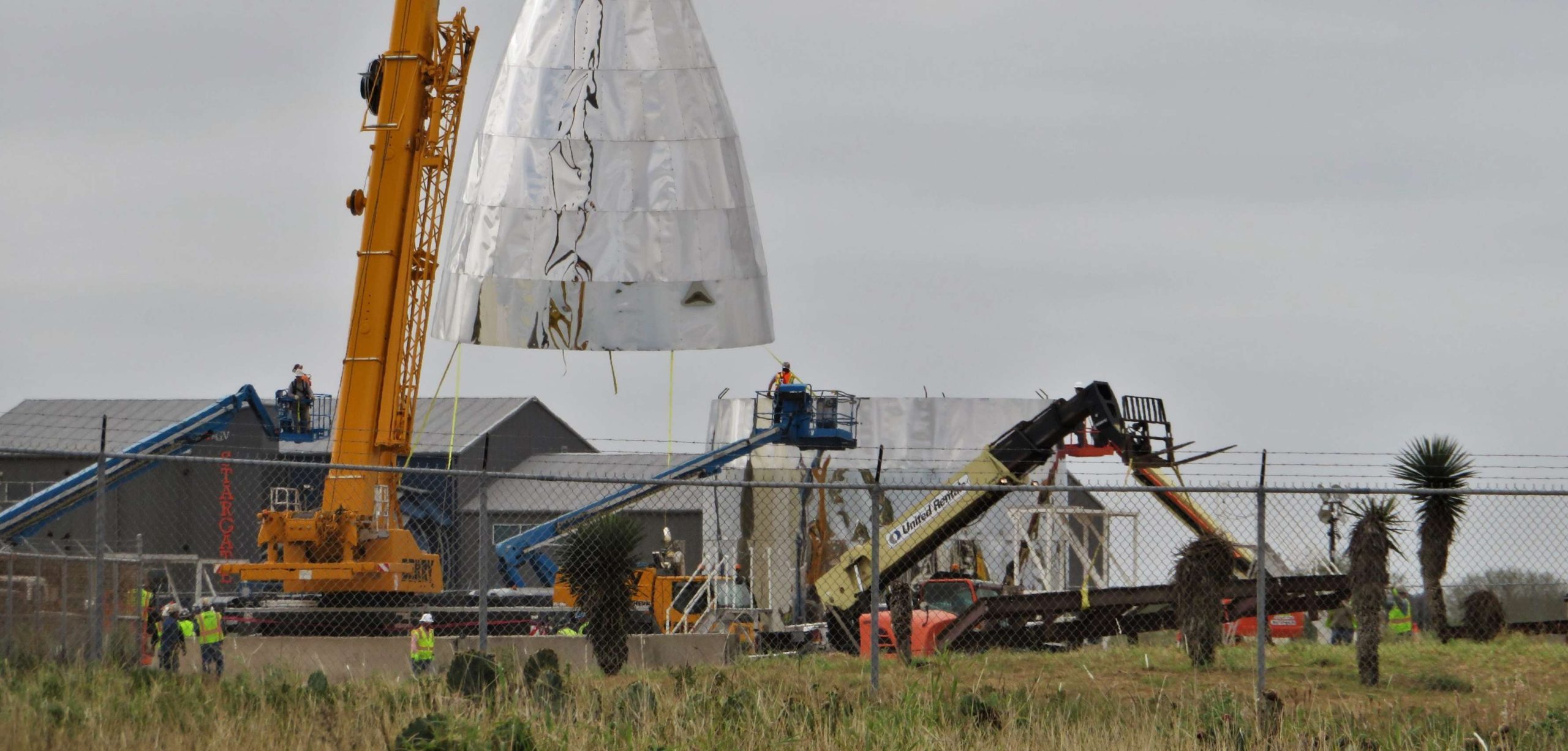
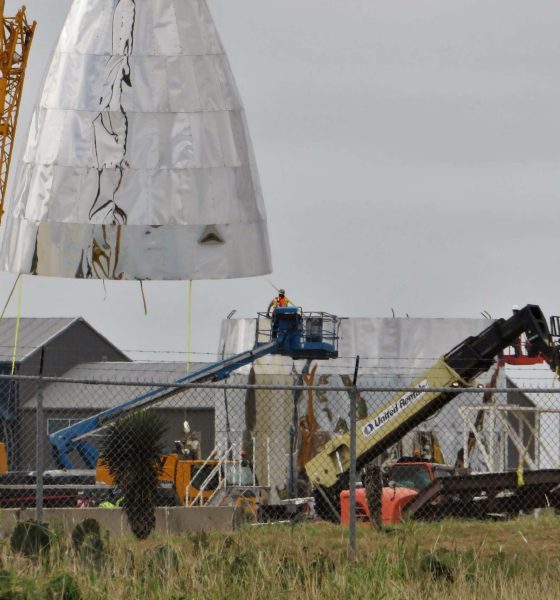
News
SpaceX’s Starship prototype proceeds at breakneck pace towards hop tests
Well illustrated by recent drone photos of SpaceX’s up-and-coming Boca Chica, Texas facilities, dozens of SpaceXers and local contractors have congregated at the company’s Starship prototype work site over the last few weeks, progressing it from an empty tent and a collection of parts to a handful of large assemblies for what appears to be the first full-scale Starship hopper.
Much like Falcon 9’s Grasshopper and F9R (Reusable) hop test articles, this ungainly Starship hopper – standing an impressive 9m (29.5 ft) wide and ~40m (131 ft) tall – appears all but guaranteed to become the first integrated BFR hardware to take flight, hopefully supporting a productive series of low-altitude hop tests from a roughly-prepared South Texas pad.
https://twitter.com/austinbarnard45/status/1079402956603248641
Since SpaceX CEO Elon Musk took to Twitter to provide a number of updates on and photos of the company’s dramatically refigured approach to BFR (now Starship and Super Heavy), employees and local contractors have been working almost around the clock to keep building the first full-scale, integrated Starship test article. To be dedicated to low-speed, low-altitude hop tests, Starhopper has been a spectacle and scandal from the start thanks to an unshakable visual aesthetic reminiscent of 1950s science fiction or an elaborate and slow-burning April Fool’s prank.
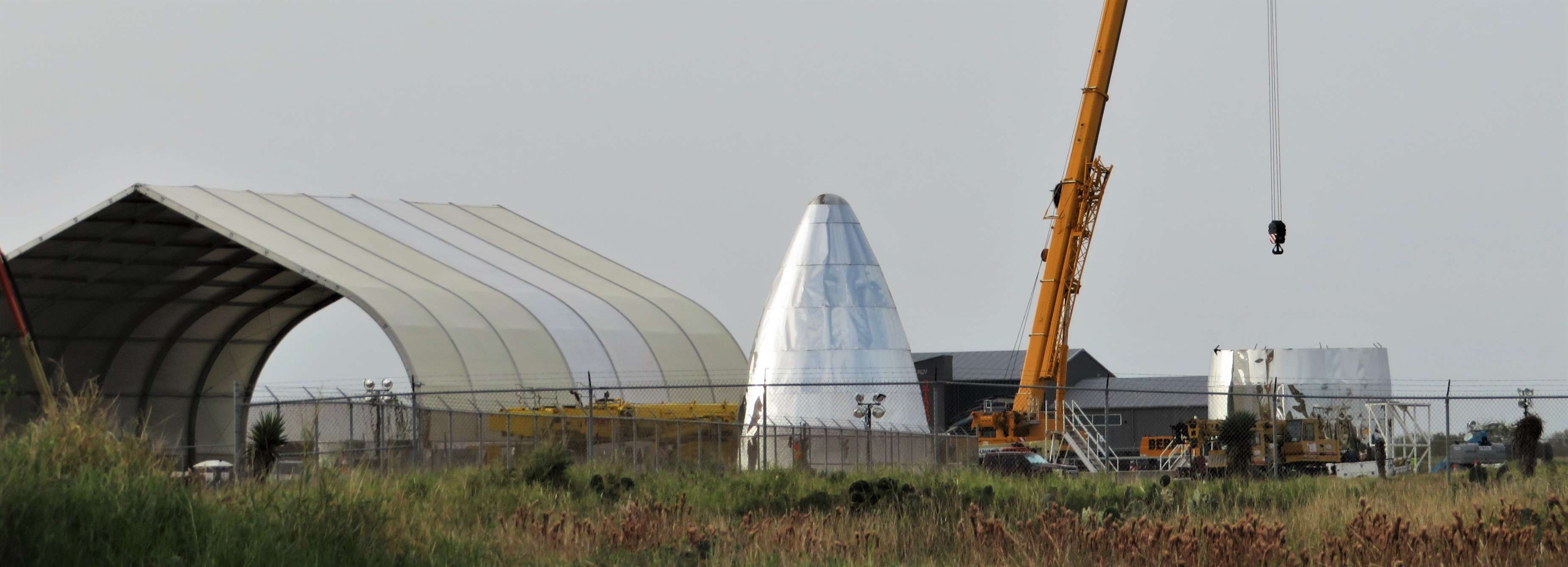
As of now, several dozen tweets and tweet replies from Musk in just the last week offer extensive support for the unorthodox new design – replacing carbon composites and an ablative heat shield for a new stainless steel alloy and liquid cooling – while also firmly indicating that the object taking shape in South Texas really is a Starship hopper that will eventually take to the skies on a pillar of Raptor engine exhaust. Those inaugural hop tests could apparently begin as early as March or April 2019. Given Musk’s statements, it seems that this highly unusual Starship hop test program simply cannot be judged accurately by its cover, at least not easily.
Even for SpaceX, building an aerospace-grade prototype of a massive orbital spaceship outdoors – adjacent to soggy Texan marshland and Gulf of Mexico sea spray, no less – is utterly and completely unexpected, especially in an industry where rocket hardware is routinely fabricated indoors, if not in medical-grade clean rooms. The most likely explanation here is that we are seeing something more akin to the aeroshell or cocoon of a Starship hopper, with a huge amount of thought and debate ultimately landing on this oddity as the fastest, most affordable, and most data-rich path forward for full-scale BFR testing.
- A welder can be seen attaching a patch layer over each panel layer gap on Dec. 30. (NASASpaceflight /u/bocachicagal)
- A lifting sling is seen here attached to Starhopper’s bottom half prior to its first lift and move. (NASASpaceflight /u/bocachicagal)
- Before the move… (NASASpaceflight /u/bocachicagal)
- And after the move. (NASASpaceflight /u/bocachicagal)
- The leftmost mockup was stitched together from NASASpaceflight user bocachicagal’s on-site photos by Thomas Lacroix. The TL;DR of this is that Starhopper appears to be a solid three-quarters the height of a full 2018 BFS. (SpaceX, NASASpaceflight, Thomas Lacroix)
In this speculative instance, the sensitive liquid methane and liquid oxygen propellant tanks – as well as Starhopper’s triple-Raptor thrust structure and spaghetti plumbing – would be fabricated in SpaceX’s Hawthorne, CA factory or McGregor, TX test facilities before being shipped to Boca Chica for integration with the large structures already in work there. Those Raptors, propellant tanks, and a general program of fit-and-finish optimizations are next on the list of significant Starhopper-related events expected to occur within the next several months.
The latter task has already begun, showing up in the form of sheet metal refinement by way of essentially stitching together loose panel gaps between and within sheet-covered sections of Starhopper’s shiny silver nose. SpaceX workers also conducted the first move of the fully-integrated hopper’s base section, previously built and then sat atop a ready-made concrete stand that may or may not have come from a water tank design. While the move was slight, the base and nose sections are now roughly side-by-side along the apron of SpaceX’s temporary tent, where a third Starhopper hull segment is being built up.
2019 is going to be wild and March/April simply cannot come soon enough.
For prompt updates, on-the-ground perspectives, and unique glimpses of SpaceX’s rocket recovery fleet check out our brand new LaunchPad and LandingZone newsletters!

News
Tesla FSD fleet is nearing 7 billion total miles, including 2.5 billion city miles
As can be seen on Tesla’s official FSD webpage, vehicles equipped with the system have now navigated over 6.99 billion miles.

Tesla’s Full Self-Driving (Supervised) fleet is closing in on almost 7 billion total miles driven, as per data posted by the company on its official FSD webpage.
These figures hint at the massive scale of data fueling Tesla’s rapid FSD improvements, which have been quite notable as of late.
FSD mileage milestones
As can be seen on Tesla’s official FSD webpage, vehicles equipped with the system have now navigated over 6.99 billion miles. Tesla owner and avid FSD tester Whole Mars Catalog also shared a screenshot indicating that from the nearly 7 billion miles traveled by the FSD fleet, more than 2.5 billion miles were driven inside cities.
City miles are particularly valuable for complex urban scenarios like unprotected turns, pedestrian interactions, and traffic lights. This is also the difference-maker for FSD, as only complex solutions, such as Waymo’s self-driving taxis, operate similarly on inner-city streets. And even then, incidents such as the San Francisco blackouts have proven challenging for sensor-rich vehicles like Waymos.
Tesla’s data edge
Tesla has a number of advantages in the autonomous vehicle sector, one of which is the size of its fleet and the number of vehicles training FSD on real-world roads. Tesla’s nearly 7 billion FSD miles then allow the company to roll out updates that make its vehicles behave like they are being driven by experienced drivers, even if they are operating on their own.
So notable are Tesla’s improvements to FSD that NVIDIA Director of Robotics Jim Fan, after experiencing FSD v14, noted that the system is the first AI that passes what he described as a “Physical Turing Test.”
“Despite knowing exactly how robot learning works, I still find it magical watching the steering wheel turn by itself. First it feels surreal, next it becomes routine. Then, like the smartphone, taking it away actively hurts. This is how humanity gets rewired and glued to god-like technologies,” Fan wrote in a post on X.
News
Tesla starts showing how FSD will change lives in Europe
Local officials tested the system on narrow country roads and were impressed by FSD’s smooth, human-like driving, with some calling the service a game-changer for everyday life in areas that are far from urban centers.

Tesla has launched Europe’s first public shuttle service using Full Self-Driving (Supervised) in the rural Eifelkreis Bitburg-Prüm region of Germany, demonstrating how the technology can restore independence and mobility for people who struggle with limited transport options.
Local officials tested the system on narrow country roads and were impressed by FSD’s smooth, human-like driving, with some calling the service a game-changer for everyday life in areas that are far from urban centers.
Officials see real impact on rural residents
Arzfeld Mayor Johannes Kuhl and District Administrator Andreas Kruppert personally tested the Tesla shuttle service. This allowed them to see just how well FSD navigated winding lanes and rural roads confidently. Kruppert said, “Autonomous driving sounds like science fiction to many, but we simply see here that it works totally well in rural regions too.” Kuhl, for his part, also noted that FSD “feels like a very experienced driver.”
The pilot complements the area’s “Citizen Bus” program, which provides on-demand rides for elderly residents who can no longer drive themselves. Tesla Europe shared a video of a demonstration of the service, highlighting how FSD gives people their freedom back, even in places where public transport is not as prevalent.
What the Ministry for Economic Affairs and Transport says
Rhineland-Palatinate’s Minister Daniela Schmitt supported the project, praising the collaboration that made this “first of its kind in Europe” possible. As per the ministry, the rural rollout for the service shows FSD’s potential beyond major cities, and it delivers tangible benefits like grocery runs, doctor visits, and social connections for isolated residents.
“Reliable and flexible mobility is especially vital in rural areas. With the launch of a shuttle service using self-driving vehicles (FSD supervised) by Tesla in the Eifelkreis Bitburg-Prüm, an innovative pilot project is now getting underway that complements local community bus services. It is the first project of its kind in Europe.
“The result is a real gain for rural mobility: greater accessibility, more flexibility and tangible benefits for everyday life. A strong signal for innovation, cooperation and future-oriented mobility beyond urban centers,” the ministry wrote in a LinkedIn post.
News
Tesla China quietly posts Robotaxi-related job listing
Tesla China is currently seeking a Low Voltage Electrical Engineer to work on circuit board design for the company’s autonomous vehicles.

Tesla has posted a new job listing in Shanghai explicitly tied to its Robotaxi program, fueling speculation that the company is preparing to launch its dedicated autonomous ride-hailing service in China.
As noted in the listing, Tesla China is currently seeking a Low Voltage Electrical Engineer to work on circuit board design for the company’s autonomous vehicles.
Robotaxi-specific role
The listing, which was shared on social media platform X by industry watcher @tslaming, suggested that Tesla China is looking to fill the role urgently. The job listing itself specifically mentions that the person hired for the role will be working on the Low Voltage Hardware team, which would design the circuit boards that would serve as the nervous system of the Robotaxi.
Key tasks for the role, as indicated in the job listing, include collaboration with PCB layout, firmware, mechanical, program management, and validation teams, among other responsibilities. The role is based in Shanghai.
China Robotaxi launch
China represents a massive potential market for robotaxis, with its dense urban centers and supportive policies in select cities. Tesla has limited permission to roll out FSD in the country, though despite this, its vehicles have been hailed as among the best in the market when it comes to autonomous features. So far, at least, it appears that China supports Tesla’s FSD and Robotaxi rollout.
This was hinted at in November, when Tesla brought the Cybercab to the 8th China International Import Expo (CIIE) in Shanghai, marking the first time that the autonomous two-seater was brought to the Asia-Pacific region. The vehicle, despite not having a release date in China, received a significant amount of interest among the event’s attendees.
